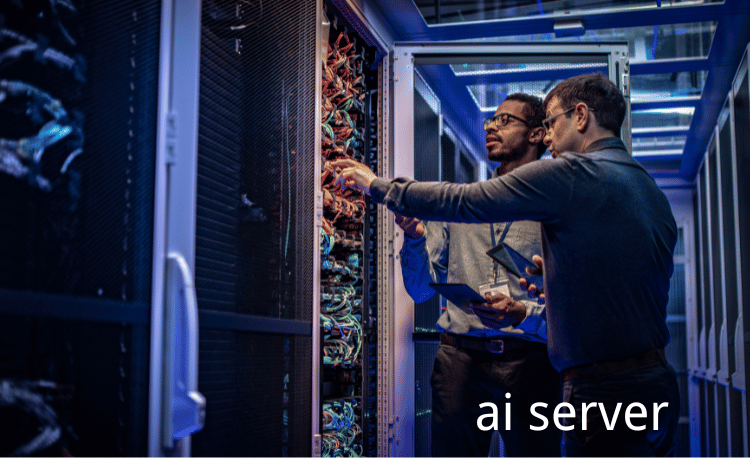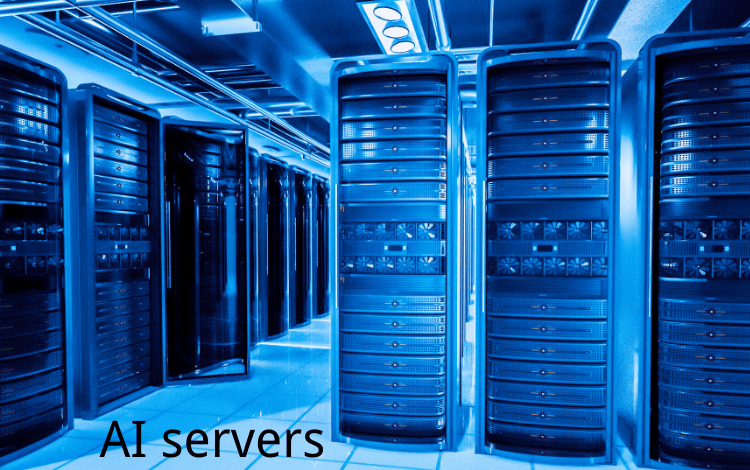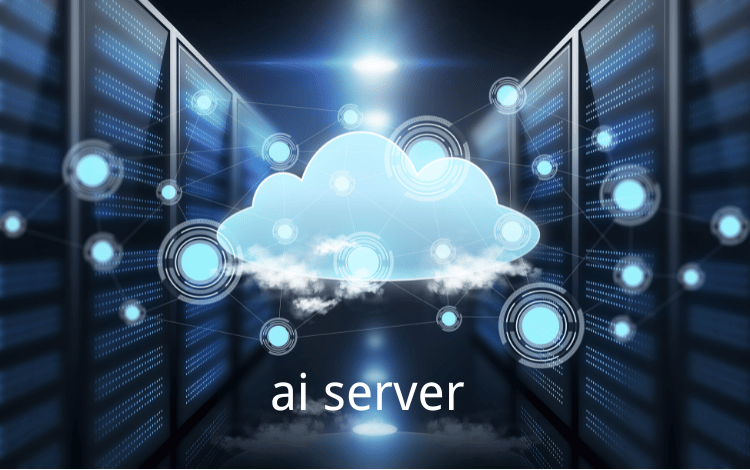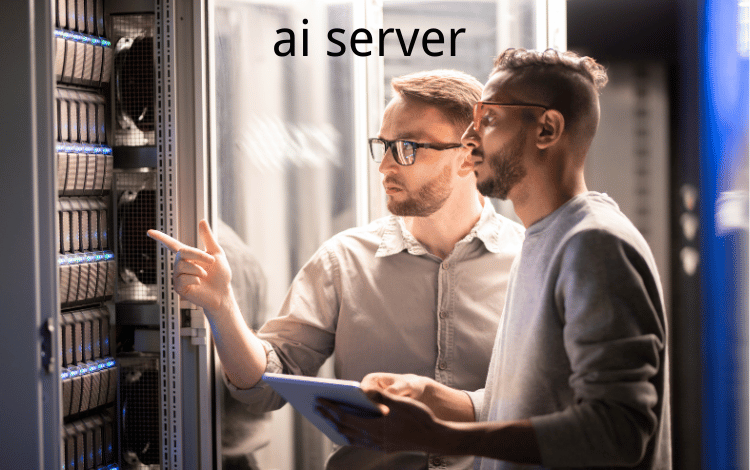Difference between AI servers and universal type servers
1. What is an AI server?
An AI server is a computing device optimized for running machine learning and deep learning tasks. Compared to traditional servers, AI servers typically feature multiple high-performance graphics processing units (GPUs) or tensor processing units (TPUs) to enable parallel processing and accelerate calculations. For example, NVIDIA's A100 GPU offers up to 312 teraFLOPS of single-precision computing power, capable of handling complex deep learning models. AI servers usually have larger memory configurations, ranging from 256GB to 2TB of RAM, to manage large datasets and model parameters. Additionally, AI servers often utilize NVMe SSDs for storage to provide faster data access speeds.

2. What is a universal type server?
A universal type server is a computing system designed to run a variety of applications, suitable for tasks ranging from database management to web hosting. universal type servers typically feature multi-core central processing units (CPUs), such as the Intel Xeon or AMD EPYC series, providing processing capabilities of up to 64 cores. Memory configurations generally range from 32GB to 512GB, optimized for various workloads. The storage options can include SATA SSDs, SAS SSDs, or HDDs, accommodating different data access needs. Their flexibility allows them to handle multiple scenarios in enterprise environments, such as virtualization, file storage, and database operations.
3. What are the hardware differences between AI servers and universal type servers?
There are significant differences in hardware configurations between AI servers and universal type servers. AI servers often come equipped with multiple GPUs, such as NVIDIA RTX 3090 or A100, which enable high parallel computing power suitable for deep learning tasks. These GPUs typically have memory ranging from 24GB to 80GB, supporting the training of large-scale models. In contrast, universal type servers primarily rely on the multi-core performance of CPUs, usually equipped with 8 to 32-core CPUs, with memory limitations typically between 32GB and 512GB. In terms of storage, AI servers tend to use NVMe SSDs for faster data transfer speeds, while universal type servers may adopt more economical SATA SSDs or HDDs.
4. What are the storage requirements for AI servers?
AI servers generally have stringent storage requirements due to the need to handle large datasets and complex models. To support efficient data read and write operations, AI servers typically utilize NVMe SSDs, with read/write speeds exceeding 3000MB per second. Most AI applications use datasets ranging from hundreds of GB to several TB, so the storage configurations for AI servers usually range from 2TB to 10TB to accommodate training and inference needs. Additionally, as the demand for big data and real-time processing increases, AI servers may deploy distributed storage solutions like Ceph or Hadoop Distributed File System for better data management and access speeds.

5. How do AI servers and universal type servers differ in network bandwidth?
AI servers typically have higher network bandwidth requirements because training deep learning models necessitates substantial data transfer. For example, in a distributed training environment, multiple AI servers might need to interconnect via a network with 10Gbps or higher bandwidth to ensure rapid data transfer. Insufficient bandwidth can create bottlenecks during training processes when handling large-scale data. In contrast, universal type servers have relatively lower bandwidth requirements, often utilizing 1Gbps Ethernet to meet the needs of most enterprise applications. universal type servers can also manage large user requests or data by employing load balancing and expanding network bandwidth accordingly.
6. How is the processing capability of AI servers?
The processing capability of AI servers is typically measured by the performance of their computing units and their parallel processing ability. For instance, NVIDIA's A100 GPU provides 19.5 teraflops of floating-point computation power, significantly enhancing the speed of training large deep learning models. AI servers usually feature multiple GPUs, allowing for greater parallel processing capabilities. For example, a server equipped with 8 A100 GPUs could achieve a total computational capacity of 156 teraflops. This makes AI servers particularly well-suited for handling complex computational tasks such as convolutional neural networks (CNNs) and recurrent neural networks (RNNs). In contrast, universal type servers primarily rely on the performance of multi-core CPUs, typically ranging between 10 to 30 teraflops, suitable for more routine computational tasks.
7. How is the energy consumption of AI servers?
AI servers generally have higher energy consumption, especially when operating under heavy loads. For example, a single AI server equipped with an NVIDIA A100 can consume between 400W to 500W, and if multiple GPUs are used, the total power consumption may exceed 2000W. This means that, during the operation of large models, the total energy consumption of AI servers can be several times that of universal type servers. universal type servers usually have power consumption ranging from 300W to 1200W, depending on the configuration and load conditions. Enterprises should consider energy consumption factors and their impact on operational costs when selecting servers.
8. What specific frameworks do AI servers need in terms of software architecture?
AI servers typically require specialized deep learning frameworks to fully leverage their hardware resources. The most commonly used frameworks include TensorFlow, PyTorch, and Keras. These frameworks provide efficient computation graphs and automatic differentiation capabilities, accelerating the training and inference processes of models. For instance, TensorFlow's support for distributed environments allows users to utilize multiple AI servers for large-scale model training. In addition to deep learning frameworks, AI servers may also require data processing and analysis tools like Apache Spark or Dask for handling training data and performing data preprocessing. In contrast, the software environment for universal type servers is more diverse, capable of running database management systems (such as MySQL and PostgreSQL), web servers (like Apache and Nginx), and more.

9. What are the differences in data processing capabilities?
AI servers have a significant advantage in data processing capabilities, particularly in handling large-scale datasets. For instance, in image recognition tasks, using an AI server for deep learning model training can process millions of image data quickly, while a universal type server might take several days to complete the same task. This difference primarily stems from the parallel computing capabilities of AI servers. Using deep learning frameworks, AI servers can simultaneously process multiple data batches, thereby improving data processing efficiency. Additionally, AI servers can further optimize data processing speed by employing more efficient data storage and transfer methods, such as data parallelism and model parallelism.
10. What are the differences in deployment environments between AI servers and universal type servers?
AI servers typically have more complex deployment environments, commonly found in cloud computing platforms and high-performance computing (HPC) centers. Many enterprises choose to deploy AI servers in cloud environments, such as AWS, Google Cloud, or Azure, to dynamically scale resources based on demand. These cloud service providers often offer instances optimized for AI tasks, equipped with high-performance GPUs. In contrast, universal type servers can be deployed in on-premises data centers or cloud-hosted environments, making them suitable for routine business applications. The deployment environment for universal type servers is more flexible, allowing enterprises to select appropriate hardware and configurations based on their needs.
11. How complex is the maintenance and management of AI servers?
The maintenance and management of AI servers are generally more complex than those of universal type servers. This complexity arises primarily from the need for specialized knowledge to configure and optimize hardware to ensure peak performance. Furthermore, the software environment of AI servers is more intricate, involving multiple deep learning frameworks and tools that require familiarity. Many enterprises opt to use specialized AI platforms or tools (like Kubeflow or MLflow) to simplify management processes. In contrast, the management of universal type servers is relatively straightforward, focusing on the operating system, network security, and backup processes. Enterprises typically have dedicated IT teams to manage universal type servers, ensuring stable operation.
12. What are the cost differences?
The construction and maintenance costs of AI servers are generally higher than those of universal type servers. For hardware, a high-performance GPU-equipped AI server can range from $10,000 to $100,000, depending on the number and performance of the GPUs. In comparison, universal type servers typically cost between $5,000 and $20,000. Beyond hardware costs, AI servers also tend to have higher electricity consumption, which can significantly increase long-term operational costs. Additionally, maintaining AI servers requires specialized personnel, further increasing costs. Enterprises must weigh performance needs against budget constraints when selecting servers.
13. What special security requirements do AI servers have?
AI servers face greater security challenges, especially when handling sensitive data. Because the training process for AI models involves large volumes of data, enterprises must ensure the privacy and security of this data. This includes employing encryption technologies to protect stored data, implementing access controls to restrict sensitive information access, and conducting regular security audits. Moreover, the training process for models may inadvertently leak training data, necessitating technical measures (such as differential privacy) to prevent data breaches. While universal type servers also require security measures, their complexity is generally lower.
14. How scalable are AI servers?
AI servers are typically designed to be highly scalable, especially in accommodating growing computational demands. Many AI servers are built to allow for easy addition of extra GPUs or storage devices, enhancing computational power and storage capacity. Distributed training also enables multiple AI servers to work collaboratively to handle larger datasets and models. For example, using distributed TensorFlow, enterprises can allocate model training tasks across multiple AI servers, significantly reducing training time. In contrast, the scalability of universal type servers is primarily limited to upgrading CPUs and memory, which is usually simpler and suitable for routine business needs.
15. How do you choose between AI servers and universal type servers?
When choosing between AI servers and universal type servers, enterprises should consider various factors, including application requirements, budget, expected workloads, and performance needs. If the primary focus is on data-intensive AI tasks, an AI server will be the more appropriate choice. Conversely, if the main needs involve running enterprise applications, databases, or web services, universal type servers are more suitable. Budget-wise, AI servers typically have higher costs, so enterprises should assess the return on investment. Lastly, organizations should also consider their future development direction to ensure that the chosen server can adapt to evolving requirements.

16. What is the environmental impact of AI servers?
The high energy consumption of AI servers is a significant environmental concern. For instance, an NVIDIA A100 GPU has a power consumption of between 400W and 500W, and an AI server equipped with multiple GPUs may consume over 2000W. Over time, the carbon footprint of AI servers can increase significantly, prompting enterprises to adopt measures to reduce energy consumption, such as optimizing algorithms and utilizing more efficient cooling systems. In comparison, universal type servers usually consume less energy and tend to be designed with energy efficiency in mind. Therefore, when selecting servers, enterprises should consider their environmental impact and explore sustainable development solutions.
17. What challenges do AI servers and universal type servers face regarding data privacy?
AI servers generally face more complex challenges regarding data privacy. This is primarily due to the enormous amounts of data processed by AI servers, which often contain sensitive information like personally identifiable information (PII). Enterprises using AI servers must comply with relevant regulations (such as GDPR or CCPA) to ensure the legality of data processing. Furthermore, the model training process might inadvertently reveal training data, necessitating technical measures (like differential privacy) to prevent data leaks. While universal type servers also face data privacy challenges, their risks are generally lower due to smaller data volumes.
18. What specialized knowledge is required for technical support of AI servers?
Technical support for AI servers requires deep expertise in machine learning and data science. Support personnel need to understand the use of deep learning frameworks (such as TensorFlow and PyTorch) and be able to optimize model performance. Additionally, maintaining AI servers requires familiarity with hardware configurations, including GPU management and optimization. Enterprises often need to train their technical teams to ensure they can effectively handle the complexities of AI servers. In contrast, technical support for universal type servers primarily focuses on operating systems, network security, and system management, with lower requirements for specialized knowledge.
19. What are the use cases for AI servers?
AI servers have a wide range of use cases, primarily in fields such as image recognition, natural language processing, and recommendation systems. For instance, in image recognition tasks, AI servers can quickly process millions of images to train convolutional neural networks (CNNs). In the natural language processing (NLP) domain, AI servers can support the training and inference of large-scale language models (such as GPT-3). Recommendation systems are also a significant application area for AI servers, analyzing user behavior data to provide personalized recommendations. In contrast, universal type servers have more diverse use cases, suitable for file storage, database management, web hosting, and other routine enterprise applications.

20. What are the future trends in server technology?
In the future, AI servers will primarily focus on performance enhancement and energy efficiency optimization. As AI applications continue to grow, the demand for computational power will increase, prompting enterprises to invest in higher-performance hardware, such as more advanced GPUs and TPUs. Additionally, with the growing awareness of sustainable development, the energy efficiency of AI servers will become an important research direction, driving the development of more efficient computing and cooling technologies. On the other hand, universal type servers will continue to evolve towards cloud computing and virtualization to meet enterprises' needs for flexibility and scalability. As technology advances, the boundaries between AI servers and universal type servers may gradually blur, resulting in more integrated computing platforms.
Summary
AI servers and universal type servers differ significantly in hardware configurations, performance requirements, use cases, and management complexities. AI servers focus on high-performance computing and big data processing, making them suitable for machine learning and deep learning tasks, while universal type servers offer flexibility to meet various enterprise application needs. Choosing the appropriate server type should involve considering specific application needs, budget, and future development directions. As technology continues to evolve, the distinction between AI servers and universal type servers may diminish, leading to more comprehensive computing solutions.
